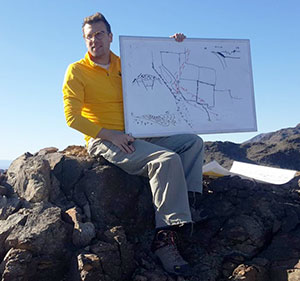
Contact Us
Institutional Communications
Bureau of Mines Building, Room 137
Laramie, WY 82071
Phone: (307) 766-2929
Email: cbaldwin@uwyo.edu

Lava Lamp Tectonics: UW Professor Suggests Giant Blobs of Subducted Sediment Float Up Through Deep Earth
Published August 02, 2021

UW Assistant Professor Jay Chapman teaches a winter-term field course in southern
Arizona, during which students were able to investigate the Orocopia Schist in person.
Chapman is the author of a new paper that suggests the rock originated as sand and
mud subducted off the coast of California around 75 million years ago, then returned
to the Earth’s crust by rising up through the mantle as enormous diapirs. (UW Photo)
A University of Wyoming professor has used computer modeling to propose that sand and mud subducted off the coast of California around 75 million years ago returned to the Earth’s crust by rising up through the mantle as enormous diapirs, like blobs in a lava lamp.
These blobs are now found at the surface of the Earth, far inland from the coast, in places including the Mojave Desert and western Arizona.
“These rocks aren’t the prettiest to look at, but they went on an extraordinary journey and have an incredible story to tell,” says Jay Chapman, an assistant professor in UW’s Department of Geology and Geophysics who focuses on tectonics.
Chapman is the author of a new paper, titled “Diapiric relamination of the Orocopia Schist (southwestern U.S.) during low-angle subduction,” which was published in the August issue of the journal Geology.
“The rocks started their lives as sediment eroded from the Sierra Nevada Mountains and carried by rivers and streams down to the ocean, where they ended up deposited in a subduction trench, similar to the modern-day Marianas trench,” Chapman says. “Then, they were carried about 20 miles deep into the Earth by a subducting oceanic plate, where the sediments were metamorphosed into a rock called schist. That in and of itself is pretty amazing, but the truly special thing about these rocks is that they didn’t stay subducted, but somehow made their way back up to the surface, where you can go stand on them today.”
How the subducted sediments returned to the surface of the Earth and the distribution of the sediments in the subsurface are some of the questions Chapman is trying to answer with his research.

Numerical modeling of sediment subducted beneath North American crust suggests that
the sediment may buoyantly rise up through the mantle, like a lava lamp blob, and
become attached to the base of the crust.
“The prevailing theory is that the sediments were smeared against and plastered to the base of the North American tectonic plate, forming a sheet-like layer,” Chapman says. “However, the density of these sediments is much lower than rocks in the mantle or lower crust and, over millions of years, computer modeling predicts that the sediments will flow and buoyantly ascend, like hot wax in a lava lamp.”
The research has implications for understanding subduction zone processes and the distribution of natural resources.
“Geoscientists around the world are working to understand what gives continental crust its unique composition, and subduction and reincorporation of sediment are a popular hypothesis,” Chapman says. “In addition, many researchers are now wondering whether fluids and elements released from the subducted sediments may have contributed to the concentration of economically important minerals and metals.”
Contact Us
Institutional Communications
Bureau of Mines Building, Room 137
Laramie, WY 82071
Phone: (307) 766-2929
Email: cbaldwin@uwyo.edu

